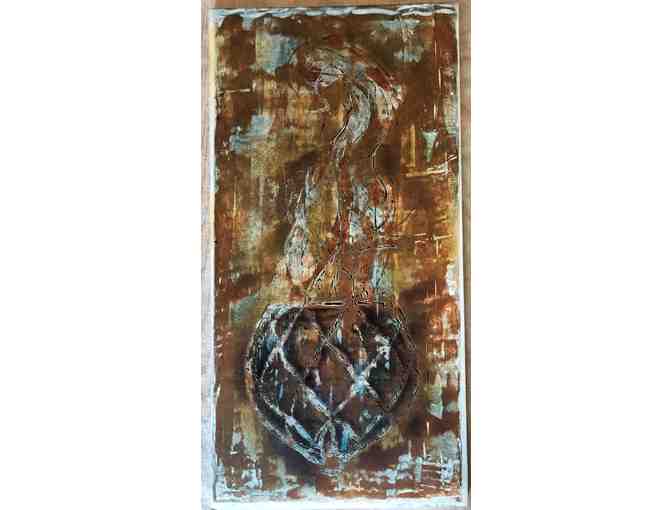The Wind Gourd Of Laa Moa O Maui - Signed Print By Mary Philpotts McGrath

Item Number: 108
Time Left: CLOSED

Description
Mary Philpotts McGrath is one of Hawaii's best known - award winning - artists, printmakers and interior designers:
“My work embraces my immediate surroundings and my native Hawaiian heritage. I use designs, images and references from ancient and modern cultures; layering them between transparent veils of color.”
– Mary Philpotts McGrath
This piece comes with a fascinating moolelo: Set mainly on Hawai‘i, Kaua‘i, and Moloka‘i, the story of The Wind Gourd of Laa Moa O Maui concerns the close relationship between the ali‘i and his kahu iwikuamo‘o, or personal attendant, and their responsibilities to each other and the people they ruled. The story portrays the ideal attendant as one who was caring and just toward both his ali‘i and the maka‘ainana, or commoners. Ancestry was essential in establishing status and access to privileges and special powers (such as control over the winds); but also important was the ability to carry out efficiently and fairly the duties of leadership.
Judging from its extensive development and the number of versions recorded in Hawaiian after Hawaiians adopted the haole writing system in the 19th century, the story seems to have been highly regarded both for its artistry and for promoting such values as honesty, generosity, loyalty, filial piety, and justice (which included vengeance). The first known publication of the legend in Hawaiian is a rendition by S.K. Kuapuu simply entitled He Wahi Moolelo, which appeared serially in the Hawaiian newspaper Ka Hae Hawaii from April 17–June 19, 1861. A version by S.M. Kamakau entitled He Moolelo no Pakaa (“The Story of Pakaa”) appeared serially in the Hawaiian newspapers Ke Au Okoa and Ka Nupepa Kuokoa from 1869-1871. Another Hawaiian text of the Paka‘a story appears in Fornander’s Hawaiian Antiquities and Folk-lore (Vol. 4, 72-135). This rendition, accompanied by an English translation, does not contain all of the incidents and chants that appear in Nakuina’s, but the two stories are similar and some of the chants are identical. Nakuina seems to have used all three of these earlier Hawaiian texts as sources for his expanded version.
English renditions of the story include a long version in William Hyde Rice’s collection Hawaiian Legends (1923); a short version in Thomas G. Thrum’s collection More Hawaiian Folktales (1923); a short, young adult’s version in Cora Wells Thorpe’s In the Path of the Trade Winds (1924); a short children’s version in Mary Kawena Pukui and Caroline Curtis’ collection The Water of Kane (1951); and most recently, a book-length young adult’s version by Marcia Brown entitled The Backbone of the King (1966), which is based on a translation of Nakuina’s text by Dorothy Kahananui. Of the English versions, Rice’s most closely resembles Nakuina’s in its completeness of plot, although Rice summarizes or omits the chants, which are important elements in the artistry and plot of the story. According to the introduction to his collection, Rice heard the story from “a man from Hawai‘i named Wiu,” but Nakuina’s story may have been the original source. This present text, unlike earlier English versions, is a complete translation rather than a simplification or summary.
The wind gourd referred to in the title of this legend was believed to contain all the winds of Hawai‘i, which could be called forth by chanting their names. According to Handy and Handy, the gourd is an embodiment of Lono, the Hawaiian god of agriculture and fertility: “Lono is the gourd; the cosmic gourd is the heavens whence come winds, clouds, and rain” (220). In the Paka‘a legend, the gourd, along with the marvelous wind chants naming dozens of local winds, is passed down from La‘amaomao, the Hawaiian wind goddess (lit. “distant sacredness”), to her granddaughter La‘amaomao; to her granddaughter’s son Paka‘a; to Paka‘a’s son, Ku-a-Paka‘a. In “The Triple Marriage of Laa-Mai-Kahiki” (Kalakaua, The Legends and Myths of Hawaii), La‘amaomao is described as a god rather than a goddess. He accompanies Moikeha to Hawai‘i from Kahiki and settles at Hale-o-Lono on the island of Moloka‘i, where he was worshiped as an ‘aumakua, or deity, of the winds. The female gender of the wind deity in the Paka‘a story seems to be a Hawaiian development as the wind deity in other Polynesian traditions is male (Ra‘a—Society Islands, Raka—Cook Islands, Raka-maomao—New Zealand).
From: Introduction to The Wind Gourd of La‘amaomao by Dennis Kawaharada / 1992
To read more: http://www2.hawaii.edu/~dennisk/texts/introwindgourd.html
About Mary Philpotts McGrath:
Professional memberships include the American Society of Interior Designers, Honolulu Print Makers, Hawaii Watercolor Society, Pastel Artist of Hawaii and Hawaii Craftsman.
Awards & Community Recognitions/Relevant Service include the John Young award for Lithography – Honolulu Prints Makers Annual Exhibition 2006; American Society of Interior Designers Lifetime Achievement Award, Hawaii; Ka Palapala Po Okela Award – Book of the Year, Hawaii A Sense of Place, Author, Commissioner with the State Foundation on Culture & the Arts under Governor Ben Cayatano, and Committee member for The City & County of Honolulu Commission on Culture & the Arts under Mayor J. Harris.
https://placehawaii.com/mary_philpotts_mcgrath-3/
Special Instructions
The fortunate winning bidder for this Mary Philpotts McGrath print will receive an email to confirm pick up day/time from Waimea Middle School. If shipping required, it is understood that the winning bidder will cover these expenses.